How to check a three-way valve in a gas boiler: DIY valve check instructions
The three-way valve is a device widely used in a wide variety of designs of domestic and industrial devices. Accordingly, the same kind of device is used as part of domestic gas equipment. Along with various malfunctions of household gas boilers, users often encounter a breakdown of the three-way valve. Agree, it would be nice to find out for what reason this device fails and try to fix it on your own.
Meanwhile, to establish the loss of operability of the device "at first glance" is far from always possible even for professional mechanics. This requires an appropriate check. Therefore, in the framework of our article, we will consider how to check a three-way valve in a gas boiler when there is a suspicion of a malfunction of this mechanism. We also talk about the varieties of the device and its functionality.
The content of the article:
Briefly about the three-way valve mechanism
The device of the three-way valve of a domestic gas boiler and other gas equipment is quite simple, despite the complex, at first glance, shape. It should be noted that for each manufacturer the design of the valves is significantly different, but the principle of operation remains virtually unchanged.
Traditionally instrument body made of bronze. Work items for example stock, springs - are made of steel. Membrane usually made of rubber double ring element. Connecting parts (fittings) may be threaded or soldered, depending on the model of the three-way valve.
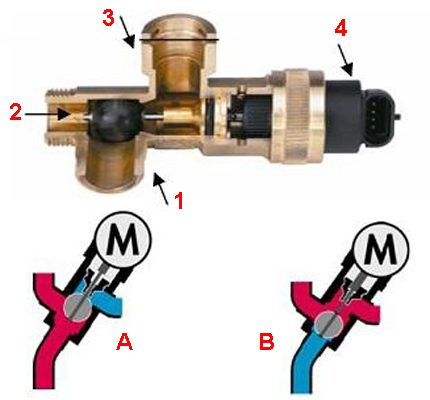
Usually, an electromechanical drive is used in conjunction with the device. Thanks to his work, two-point regulation is carried out.
So, the actuator for a three-way valve can be manual, electromechanical (thermostatic, with a thermal head), electric, hydraulic.
The principle of operation of the three-way valve for the gas boiler circuit is approximately the following: when the device is in the normally open transport mode, the direct passage channel, respectively, is open. The corner passage channel remains closed.
A different state of the mechanism provides the opening of the angular transport channel and the blocking of the direct transport channel, respectively. Intermediate stem positions and three-way valve flaps are also possible.
We talked more about the device and the principle of operation of the three-way valve in following material.
Functional use of the device
If we consider the mechanism of switching flows from the point of view of possible functionality, it should be noted the difference in devices according to the principle of operation:
- Separating.
- Switching.
- Mixing
The dividing principle of work involves the division of the flow, directing it into two circuits.
The switching function provides for the organization of switching between devices that consume thermal energy. For example, switching between DHW and heating double-circuit gas boiler.
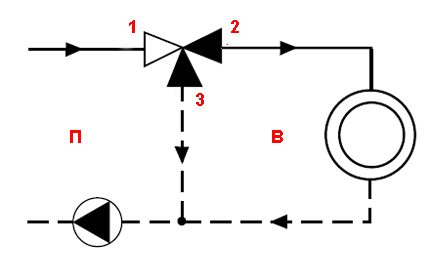
Switching functionality allows you to organize effective switching between different devices that generate thermal energy:
- water heaters;
- heat pumps;
- solar panels, etc.
Another function of a three-way valve for a domestic gas boiler is mixing. It allows you to organize controlled mixing of the flow of the working fluid (mixing the return to the heated coolant).
To do this, it is enough to install a three-way valve on the return pipe of the heating system.
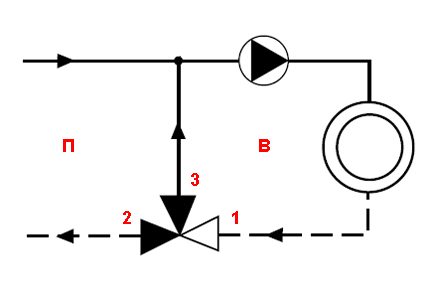
Now, after a brief acquaintance with the structural details of the device, you can consider the features of checking the operation of the three-way valve installed in gas boiler circuit.
How is a three-way valve checked?
A malfunction of the device affects the operation of the gas boiler as a whole. For example, if the supply of coolant is insufficient, the gas boiler may simply turn off due to overheating. Or, a malfunction of a three-way valve may be accompanied by a lack of a proper heating medium temperature in the heating system.
In any case, the device must be checked for operability. At the same time, for the execution of diagnostic measures, the regulating device of the gas boiler, as a rule, has to be dismantled. Dismantling is relatively uncomplicated, so such work can well be done on its own.
Step # 1 - Check Valve Actuator
Next, we examine the verification process step by step, starting with checking the drive. Consider the features of diagnostics of valves with various types of actuators.
Diagnostics of a three-way valve actuator
The valve stem is traditionally controlled by an electric actuator. Therefore, the integrity, availability of power, and operability of the drive should be checked first.
The integrity of the external part is checked visually by careful inspection, and the availability of power and the integrity of the internal mechanism are checked by appropriate devices.
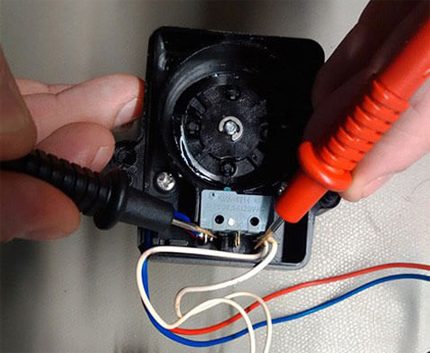
The drive and all elements of this part of the structure are usually diagnosed by an electric tester. This device can check both the integrity of the circuits and the presence of supply voltage. A serviceable drive when applying / disconnecting the supply voltage should demonstrate the working process - the movement of the valve rod pusher.
It is permissible to check the operation of the electric drive by directly connecting the mechanism to the electric current network, using the connector with which the drive is equipped. This moment is clearly highlighted in the video located at the end of the article.
Checking the thermostatic head
If the design of the three-way valve does not provide for an electric drive, but is controlled thermostatic head, you need to check this part of the system by applying a temperature effect directly to the sensor cylinder.
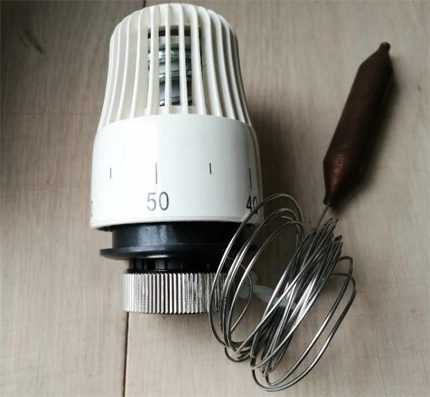
For example, you can heat the cylinder of a thermostatic head with an electric hairdryer.
A working thermal head should respond to temperature changes and push / pull the valve stem in the same way as the electric drive does this work.
Checking the hydraulically driven device
If a valve is used in the gas boiler system that controls the flows and operates according to the principle of hydraulic control of the stem, it is quite difficult to diagnose the operability of such a device directly in the boiler system.
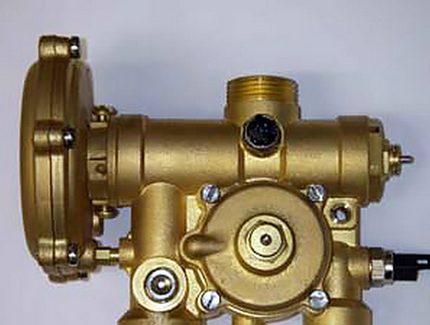
Typically, this kind of design is subject to dismantling and disassembly, followed by integrity check:
- springs;
- seals;
- membranes;
- rings.
Suspicions of the inoperability of the three-way valve, in this case, can be confirmed by starting the gas boiler in test mode. If at the same time there is a violation of the thermal distribution along the working circuits of the system, by 90% the valve does not work correctly.
Step # 2 - checking the thread allocation mechanism
The mechanism of the device during operation is able to wear out. In addition, during transportation of the coolant, the accumulation of various debris, deposits, etc. in the system is characteristic.
All this can block the operation of the device. Therefore, first of all, it is required to carry out visually checking all available parts.
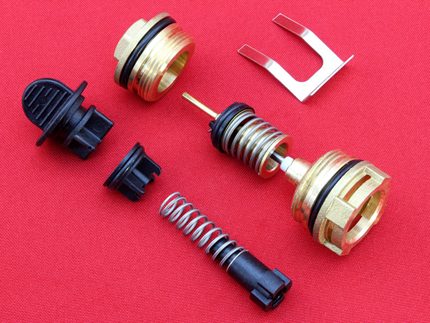
Next is executed checking the normal course of the diaphragm rod. As a rule, being in working condition, the rod moves smoothly, with some interference. The correctness of the stroke can be checked by acting with little force on the end part of the stem (exit under the actuator), which exits through the opening of the valve body capsule.
If wedge factors of the stroke of the rod along the entire length are not noted and the rod independently returns to its original position from the stop point, then this part of the switchgear is operational.
Finally, sealing elements are checked - ball or membrane, depending on the design. While defects on rubber sealing membranes usually manifest as gusts, ball seals can become deformed over time. The deformation factor leads to the loss of full compaction, respectively, the flow control algorithm of the device is violated.
Conclusions and useful video on the topic
Below is provided for familiarization a useful video material, which demonstrates the disassembly of a device that regulates heat fluxes in a gas boiler. Moreover, the practice of disassembling with their own hands is given.
The distribution device described by the video is equipped with a hydraulic stem drive. Familiarization with this repair practice will help you understand how to check devices of a similar type and repair in case of defects.
Thus, the three-way valve for a domestic gas boiler can be tested in almost any design, regardless of individual performance. The main point is to correctly determine with which drive the switchgear of the gas boiler is used. Information on this subject can be obtained from the documentation for the equipment or based on examples of demonstration of drives in this article.
Do you have useful information on the topic discussed above and want to share it with other users? Write your comments and comments in the block below, add photos, leave your recommendations - the feedback form is located below.

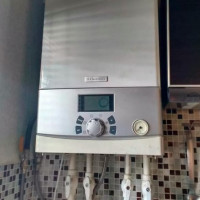 Error E4 in a gas boiler: decryption of code E04 + steps to solve the problem
Error E4 in a gas boiler: decryption of code E04 + steps to solve the problem 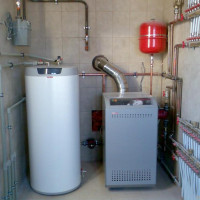 Why pressure drops in a gas boiler: causes of instability of pressure + ways to prevent problems
Why pressure drops in a gas boiler: causes of instability of pressure + ways to prevent problems  What to do if condensate in a gas boiler: methods for preventing the formation of “dew” in a chimney
What to do if condensate in a gas boiler: methods for preventing the formation of “dew” in a chimney 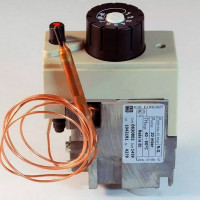 Repairing a gas boiler valve: how to fix a unit by correcting a typical malfunction
Repairing a gas boiler valve: how to fix a unit by correcting a typical malfunction 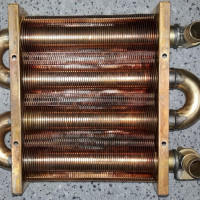 Do-it-yourself gas boiler heat exchanger repair + instruction on repair and part replacement
Do-it-yourself gas boiler heat exchanger repair + instruction on repair and part replacement 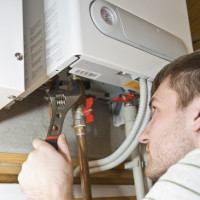 Wall-mounted gas boiler installation: do-it-yourself installation
Wall-mounted gas boiler installation: do-it-yourself installation  How much does it cost to connect gas to a private house: the price of organizing gas supply
How much does it cost to connect gas to a private house: the price of organizing gas supply  The best washing machines with dryer: model rating and customer tips
The best washing machines with dryer: model rating and customer tips  What is the color temperature of light and the nuances of choosing the temperature of the lamps to suit your needs
What is the color temperature of light and the nuances of choosing the temperature of the lamps to suit your needs  Replacement of a geyser in an apartment: replacement paperwork + basic norms and requirements
Replacement of a geyser in an apartment: replacement paperwork + basic norms and requirements